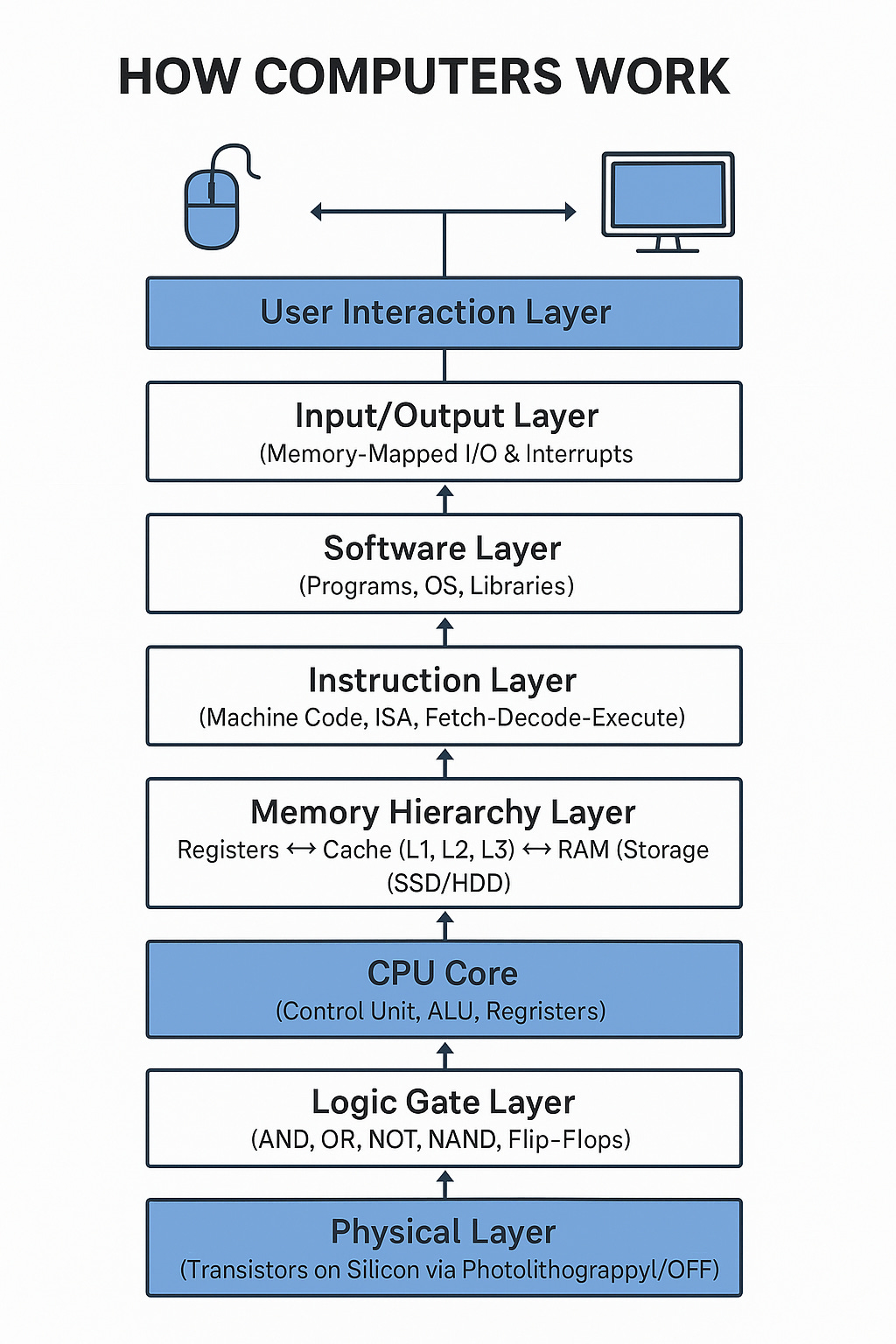How Computers Work: From Electron to User
A simplified breakdown of how computers work.
Understanding how computers work at their most fundamental level isn’t just for engineers, it’s the key to truly mastering technology.
From the movement of electrons in silicon to the layers of logic, memory, and software, each step builds on the last to create the seamless experience we take for granted.
This knowledge allows you to see through the abstractions, understand performance bottlenecks, and make informed decisions when building, troubleshooting, or optimizing systems.
It’s the difference between being a user of technology and being someone who can actual manipulate and improve technology.
Sad to say, I didn’t know how computers really worked until very recently.
Layers of Computers: from Electrons to Excel
1. Physical Layer — Electrons & Transistors
Computers are built on silicon semiconductors, doped to form transistor regions that control electron flow.
A transistor acts as an electronic switch, turned ON or OFF by voltage at its gate.
Billions of transistors are fabricated on a silicon wafer using photolithography — a process that uses light and masks to etch microscopic patterns layer-by-layer.
The ON/OFF states correspond to binary 1s and 0s, representing digital information.
2. Logic Gate Layer — Boolean Circuits
Transistors are combined to form logic gates (AND, OR, NOT, NAND, XOR, etc.).
Logic gates perform basic Boolean operations, which are the foundation of digital logic.
These gates build combinational logic (outputs depend solely on inputs) and sequential logic (outputs depend on inputs and previous states via memory elements like flip-flops).
3. Arithmetic & Control Layer — CPU Core Components
Logic gates form the Arithmetic Logic Unit (ALU) — performs math and logical operations.
The Control Unit orchestrates the CPU, fetching instructions, decoding them, and controlling data flow.
Registers are ultra-fast small storage locations within the CPU for temporary data.
The CPU operates in cycles synchronized by a clock signal, executing billions of instructions per second.
4. Memory Hierarchy Layer
Registers and CPU caches (L1, L2, sometimes L3) are fastest but smallest memory close to the CPU.
RAM (Random Access Memory) holds data and instructions for active processes; it’s volatile and slower than cache.
Persistent storage (SSDs, HDDs) stores programs and data long-term.
Data moves across these layers over the system bus (data bus, address bus, control bus).
5. Instruction Layer — Machine Code & ISA
Software instructions are encoded as machine code (binary sequences).
The CPU architecture defines the Instruction Set Architecture (ISA) — the set of opcodes and instruction formats it understands.
CPUs perform the fetch-decode-execute-writeback cycle to run instructions.
Modern CPUs optimize execution with techniques like pipelining, out-of-order execution, and branch prediction.
6. Software Layer — Compilers, Operating Systems, & Programs
High-level languages (C, Python, Java) are translated into machine code via compilers or interpreted at runtime.
The Operating System (OS) manages hardware resources, memory, processes, and device communication.
Programs run as processes managed by the OS, which provides APIs for hardware access and system services.
Reusable compiled code is packaged as libraries (DLLs, shared objects).
7. Input/Output Layer — Devices & Communication
Devices like keyboards, mice, displays, and storage communicate via I/O controllers and buses.
Memory-mapped I/O and interrupts allow devices to exchange data with the CPU efficiently.
Displays render pixels by controlling subpixels (e.g., RGB), where each color channel intensity is represented by bits (often 8 bits per channel).
Sound is stored as digital samples, converted to analog signals via DACs for speakers.
8. User Interaction Layer
User inputs (keystrokes, mouse movements) are converted into signals, interpreted by software, and cause visible or audible changes.
Output devices convert digital data back into forms humans perceive (images, sounds, tactile feedback).
The whole system abstracts billions of electron switches into user-friendly applications and interfaces.
Example
Electron Flow → Physical Layer:
Voltage switches millions of tiny transistors on/off on silicon chips, forming the physical basis of computing.Logic Gate Layer:
Transistors connected as gates perform boolean logic operations; combined into circuits performing arithmetic and storage.CPU Core:
Executes instructions, using registers for temporary data, ALU for calculations, and Control Unit to direct operations synchronized by clock cycles.Memory Hierarchy:
Fastest memory is close to CPU (registers and caches), then RAM for active data, then slower persistent storage for long-term files.Instruction Layer:
CPU runs machine code instructions defined by ISA, decoding and executing instructions in cycles.Software Layer:
OS manages hardware and processes, programs compiled or interpreted into machine instructions, libraries share reusable code.I/O Layer:
Devices communicate via buses and controllers, using interrupts and memory-mapped I/O for efficient data transfer.User Interaction Layer:
Humans send inputs and receive outputs, interacting with digital systems abstracted from the physical electron switching beneath.
Computers are a marvel of layered design—each level, from transistor to user interface, plays a critical role in turning binary states into meaningful work.
By understanding the flow from electrons to applications, you gain the insight to use technology more effectively and innovate with confidence.
Mastering these foundations equips you to bridge the gap between hardware and software, and between concept and creation.


